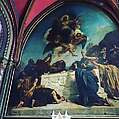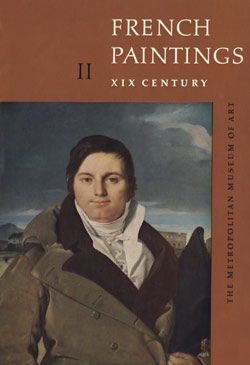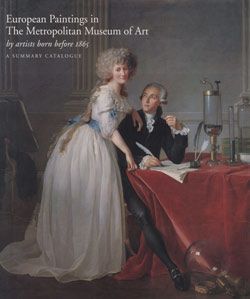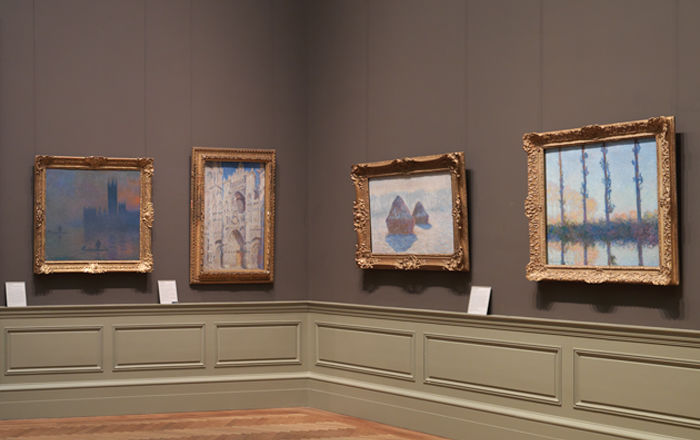The Artist: Léon Joseph Florentin Bonnat was born on June 20, 1833, at Bayonne, in the overlap between the southwestern French region of Gascony and the northern part of the Basque region, which straddles France and Spain. From 1846 to 1853, Léon lived with his family in Madrid, where his father owned a bookshop. There he studied with José de Madrazo y Agudo (1781–1859) and his son Federico de Madrazo y Küntz (1815–1894), and he visited the Prado. After moving to Paris in 1854, he entered the popular atelier of Léon Cogniet (1794–1880) at the Ecole des Beaux-Arts. Bonnat competed for the Prix de Rome in 1854, 1855, and 1857, when he won second prize with a religious subject, the
Resurrection of Lazarus, which he bequeathed with the contents of his atelier and his excellent collection of drawings to the museum he founded in Bayonne in 1901, known today as the Musée Bonnat-Helleu.
Between 1858 and 1860 Bonnat resided in Italy, where he befriended fellow painters Edgar Degas, Gustave Moreau, and Jean-Jacques Henner. One result of his Italian sojourn was an affinity for scenes of everyday life, such as Roman Girl at a Fountain (The Met,
87.15.137), painted to order for New York collector Catharine Lorillard Wolfe in 1875. However, Bonnat’s mature career was given over largely to portraiture. Typical of his sitters’ stature was John Taylor Johnston (1820–1893), founding president of The Metropolitan Museum of Art, whose portrait was commissioned by its trustees and executed in 1880 (The Met,
80.8).
Bonnat was a superb figural draftsman. He opened his studio to students in 1865, began teaching at the Ecole des Beaux-Arts in 1883, was appointed a
chef d’atelier there in 1888, and made director of the institution in 1905. In December 1867, he was invited by painter Jean-Léon Gérôme to join an expedition to Egypt and the Levant, which lasted from January to April 1868, and which resulted in a handful of Orientalist subjects. A fondness for Spanish painting, Titian, and Rembrandt underlays Bonnat’s sympathy for Courbet and Manet. And, despite Bonnat’s academic training, practice, and pedagogy, his emphasis on simplicity and effect over slick finish and unnecessary details led younger artists to appreciate his openness, even if more progressive students abandoned his academic style: for example, French Impressionist Gustave Caillebotte was a pupil, as was the American painter John Singer Sargent.
Bonnat never married. He lived in an apartment in Place Vintimille, Paris, with his sister and mother. He died at Monchy-Saint-Eloi, about thirty miles north of Paris, on September 8, 1922.
The Painting: A lifesize woman stands in a summary landscape supporting a sleeping child balanced on her shoulders. In fact, the child is off balance, but the woman’s arms, hands, and head compensate for the awkwardness with an embrace that seems at once improbable and entirely natural. Contributing to the tenderness of the grouping are the mother’s downcast or closed eyes, and her scarf covering the child’s face as protection from the desert heat or windblown sand. This secular painting of contemporary life in a distant land is redolent of the bond between mother and child long central to European art (see The Met,
2004.442).
Bonnat exhibited the painting at the Paris Salon of 1870, where it was entitled
Femme féllah et son enfant. The English translation of the Arabic word
fellah is “peasant.” Bonnat produced the painting in 1869 and 1870, shortly after visiting Egypt in the first half of 1868. Based on available evidence, it is not possible to conclude whether Bonnat painted the figural grouping more or less as he witnessed it there, or if he conjured the scene after he returned to France, where he executed the canvas in his studio.
Features of the woman’s face closely resemble those of a model who posed for Bonnat in Cairo, whom he depicted in two head studies (one in a private collection, the other unlocated).[1] Bonnat appears to have integrated qualities recorded in the studies into the more idealized visage in the painting: the flesh tones, the oval head and planar face with its straight, somewhat flat nose and full lips, and the placement of the eyebrows on the narrow strip of forehead beneath the line of the kerchief. The tattooing on the forehead and chin are the same in The Met picture and the studies.[2]
The woman who posed for Bonnat in Cairo evidently posed there for Gérôme, who made a drawing of her. That likeness, bearing the name
Fatma, was reproduced as the frontispiece of
Le Fayoum, le Sinaï et Pétra: Expédition dans la moyenne Egypte et l’Arabie pètrée sous la direction de J.-L. Gérôme, whose author, Paul Lenoir (1843–1881), was another traveling companion in 1868.[3] The book was published in Paris, in 1872, after
An Egyptian Peasant Woman and Her Child was first exhibited to the public.
An Egyptian Peasant Woman and Her Child was Bonnat’s first major painting linked thematically to his 1868 trip to Egypt. Others include
The Turkish Barber, 1872 (State Pushkin Museum, Moscow, Ж-3490), and
The Barber at Suez, 1876 (Minneapolis art market in 2022).[4] The works are striking for Bonnat’s focus on intimacy between two figures in everyday situations, expressed largely through the disposition of arms and hands. It is no coincidence that he employed this feature of his pictorial syntax on the heels of his complex multi-figure composition
The Assumption of the Virgin, an 1863 commission for the Church of Saint-André in Bayonne, which he exhibited at the Paris Salon of 1869 before its installation in its chapel dedicated to the Virgin Mary [see fig. 1 above].[5]
Early History and Reception: The Salon opened on May 1, 1870. Given its Egyptian subject, Bonnat’s painting would have been regarded by Parisian audiences in the context of the recent opening, on November 17, 1869, of the Suez Canal.[6] This French engineering triumph linked the Mediterranean and Red Seas, shortening voyages that otherwise required circumnavigating the entire continent of Africa. However, the celebratory atmosphere surrounding the achievement was interrupted. The Salon, which closed on June 20, 1870, was followed on July 19 by the Franco-Prussian War, the downfall of the French Third Empire, and the ensuing calamity of the Paris Commune and its suppression in 1871.
Initial reactions to the painting were mixed. One Salon critic, Marius Chaumelin, took Bonnat to task for its facture. He wrote: “The Orientalists are not shining at the Salon this year. The
Fellah Woman and Her Child, by M. Léon Bonnat, comprises an elegant, severe, and very sculptural group—too sculptural, even, because certain passages are impasted to the point of presenting in veritable relief. These rough areas [of the surface] catch the light, weigh down the forms, and repel the public, who assuredly prefer the
Young Fellah Girl, wisely and properly painted by M. Lecomte-Vernet [fig. 2] in the style of [Charles] Landelle. There is also heaviness and an absolute lack of transparency in the
Street in Jerusalem [location unknown], the other painting by M. Bonnat.”[7]
In contrast to Chaumelin, Théophile Gautier championed the “forcefulness, strength, and unparalleled brio” manifest in Bonnat’s shift to Egyptian genre subjects (from Italian ones). Writing in first-person plural, Gautier added: “It’s a life-size figure, naked up to the knee, a portrayal of a race whose exactitude we can accredit.”[8] In Gautier’s terms, race comprised a set of physiognomic and cultural characteristics that held together as a distinct type. This usage was particular to its time and place, and while it may seem at odds with Bonnat’s expressive visual language, it was of a piece with the authoritative voice employed by many art critics of the period. In the same fashion, Gautier reported that
An Egyptian Peasant Woman and Her Child was a painting that Bonnat “sends us from Egypt,” although that was not literally the case, since it was painted in France.[9]
Another writer, Konrad Bertrand, ascribing the picture’s painterly surface to art-historical precedent, paid Bonnat a back-handed compliment nevertheless. At first, he appears to condemn the painting: “In his new style, Mr. Bonnat seems to prefer original ugliness to classic beauty. He seeks inspiration neither from Raphael nor even Titian. He belongs more to the naturalists than to the idealists and, in this respect, he is very close to the Neapolitan school.” But Bertrand then switches track, concluding: “M. Bonnat. . ., in his
Egyptian Peasant Woman and in his
Street in Jerusalem, affirms his robust talent yet again.”[10]
Variants: First, a painting in oil on paper, laid down on canvas, and measuring only 9 7/16 by 5 1/2 inches (24 x 14 cm), has sometimes been regarded as a study for the Salon picture and at other times a smaller variant, and should be dated about 1868–70 (Gilles Kramer collection, Charenton-le-Pont, in 2022). Bonnat signed the painting and donated it to an auction organized to benefit the widow of academic painter Louis Lamothe (1822–1869), held in Paris on June 11, 1870. The composition is distinguished by the woman being presented full-length, but wearing jewelry and accessories, as well as the facial tattoos, seen in The Met picture. Here the setting features a rocky escarpment at the left and a figure on a camel at the right; the sky is blue. Entitled
La femme fellah in the sale catalogue, it was described in a post-sale article as a “little reduction of the painting exhibited [at the Salon] by Bonnat.”[11]
A second version, which, at 94 7/8 by 55 5/16 inches (241 x 140.5 cm), is even larger than The Met picture, was kept by the artist until his death and bequeathed to the Musées Nationaux de France; it has been in the Musée Bonnat-Helleu, Bayonne, since 1922 (inv. 558). The woman—here depicted full-length, as in the little version painted in oil on paper, but without jewelry and accessories—is flanked by low hills in the distance. A body of water is glimpsed behind her, and the sky is mottled. Although signed, the Bayonne painting is unfinished. As late as 1879, the artist’s biographer Achille Fouquier wrote: “
The Fellah Woman was to be reproduced full-length (she was only painted up to the knees), but it is still unfinished.”[12]
The final known variant is
Femmes fellah au lavoir, which measures 39 3/8 by 23 13/16 inches (100 x 60.5 cm; location unknown). In this scene the woman and child are one pairing among three, situated at the water’s edge in a desert town. There are competing claims for its early provenance. According to one source, the artist sold the painting to Albert Shetty of Switzerland.[13] Another source names the painting’s first owners as Félix Pascault and his son, Léon Pascault, who reportedly sold it in 1891.[14] Further research would confirm whether one or both periods of ownership are correct. What seems certain is that the painting was exhibited at the Cercle de l’Union Artistique in Paris, in 1873. Yet the date of the painting has not been determined conclusively. In a letter to the Bayonnais banker Arnaud Détroyat (1836–1911), dated December 31, 1869, Bonnat wrote: “I've just demolished some fellah women, and I'm very close to sending the canvas to the devil.” This letter has been associated with The Met picture, but the artist’s use of the plural suggests that he was referring instead to the multifigure painting.[15]
Asher Miller 2025
[1] Saigne vol. 1, 2017, pp. 362–63, nos. 189 (private collection) and 190 (location unknown). The connection between the first study, which is signed and inscribed “Au Caire, 1868,” was first suggested by Serge Lemoine (letter, March 24, 1986, Department of European Paintings files).
[2] The custom of tattooing among women was described by Edward William Lane in
Manners and Customs of the Modern Egyptians [first ed., 1836], later ed., J. M. Dent and Sons, London, 1908, esp. pp. 40–42. See also Winifred S. Blackman,
The Fellahin of Upper Egypt [first ed., 1927], reprint ed., American University in Cairo Press, 2000, pp. 52–54.
[3] On the model Fatma and Gérôme’s frontispiece, see Andral et al. 1993, pp. 42, 76, and Saigne 2022, pp. 362–63, nos. 189–90.
[4] Saigne 2022, vol. 2, pp. 255–57, no. D b12, and pp. 258–59, no. D b13. The paintings were exhibited at the Paris Salon in 1873 and 1876, respectively.
[5] See Saigne 2022, vol. 2, pp. 111–17, nos. A. 9 and ff.
[6] During Bonnat’s lifetime writers began to claim, falsely, that Bonnat attended the opening of the Suez Canal, and this error has been repeated frequently (for example, Strahan 1880, p. 54, Cicerone 1880, Rowlands 1889, Sharp 1898, Sterling and Salinger 1966, p. 187).
[7] “
Les orientalistes ne brillent pas cette année au Salon. La Femme fellah et son enfant, de M. Léon Bonnat, forment un groupe élégant, sévère et bien sculptural,—trop sculptural, même, car certaines parties sont empâtées au point de présenter un véritable relief. Ces rugosités accrochent la lumière, alourdissent les formes et rebutent le public, qui préfère assurément la Jeune fille fellah, sagement et proprement peint par M. Lecomte-Vernet, dans le goût de M. Landelle. Il y a de la lourdeur aussi et un manque absolu de transparence dans le Rue à Jérusalem, l’autre tableau de M. Bonnat.” Chaumelin 1870. On Bonnat’s
Street in Jerusalem see Saigne 2022, vol. 2, pp. 247–48, no. D. b5, ill.
[8] “. . .
La force, la hardiesse, le brio sans pareil. . . C’est une figure de grandeur naturelle, nue jusqu’au genou, un portrait de race dont nous pourrions certifier l’exactitude.” Gautier 1870.
[9] “
A Peasant Woman and Her Child, that is the title of the painting that M. Bonnat sends us from Egypt. . . .” (“Une Femme fellah et son enfant, tel est le titre du tableau que M. Bonnat nous envoie d’Égypte.”) Gautier 1870.
[10] “
Dans sa nouvelle manière, M. Bonnat semble préférer la laideur originale à la beauté classique. Ce n’est ni chez Raphaël ni même chez Titien qu’il cherches ses inspirations. Il appartient plutôt aux naturalistes qu’aux idéalistes, et il se rapproche beaucoup sous ce rapport de l’école napolitaine.” Bertrand 1870, p. 298. “
M. Bonnat. . ., dans sa ‘Femme fellah’ et dans sa ‘Rue de Jérusalem,’ affirme toujours son talent robuste.” Bertrand 1870, p. 308.
[11] The painting is in the collection of Gilles Kramer, Charenton-le-Pont. For the sale:
Vente des tableaux, dessins et objets d’art offerts par divers artistes à veuve du peintre Louis Lamothe, Hôtel Drouot, Paris, June 11, 1870, no. 4, as
La Femme fellah. For the reference to the sale, see La France 1870, p. 2, “
petite réduction du tableau exposé cette année par Bonnat, Fr 805." See Saigne 2022, vol. 2, pp. 248, no. D. b4E, ill. on p. 246; and esp. Couilleaux 2022, pp. 148–49, no. 39, ill.
[12] “
La femme fellah devait être reproduite en pied (elle n’avait été peinte que jusqu’au genoux), mais elle est encore inachevée.” Fouquier 1879, p. 170. See also Saigne 2022, vol. 2, pp. 246–47, no. D. b4C, ill.
[13]
19th Century European Paintings, including German, Austrian, Hungarian & Slavic Paintings, The Orientalist Sale, and The Scandinavian Sale, Sotheby’s, London, June 15, 2004, no. 119, bought in;
19th Century British and Continental Paintings, Sotheby’s Olympia, London, November 30, 2005, no. 263, for £4,800, together with a certificate attesting to its authenticity, which the artist evidently signed and dated December 8, 1920.
[14] Saigne 2022, vol. 2, pp. 253, 255, no. D b11, ill.
[15]“ . . .
je viens de démolir des femmes fellah et il s'en faut de bien peu que je n'envoie la toile aux mille diables . . . ” Détroyat family archive, quoted in Saigne 2022, vol. 2, p. 245.






